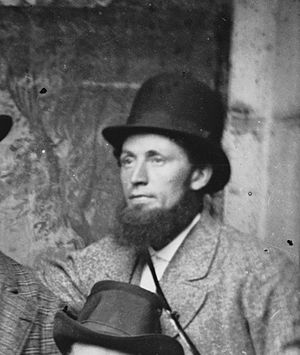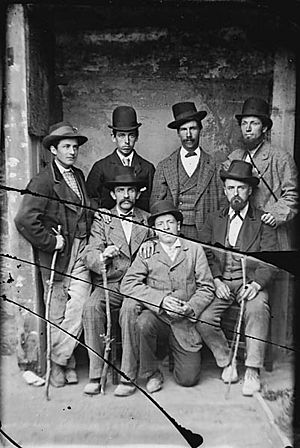John Thomas (photographer) facts for kids
Quick facts for kids
John Thomas
|
|
|---|---|

Thomas, from a group portrait in his own collection
|
|
| Born | 14 April 1838 Llanfair Clydogau near Lampeter, Wales
|
| Died | 14 October 1905 Liverpool, England
|
| Nationality | Welsh |
| Occupation | Photographer |
John Thomas (born April 14, 1838 – died October 14, 1905) was a famous Welsh photographer. He was known for his beautiful pictures of the Welsh countryside, especially its chapels. He also took many portraits of important Welsh people, like church leaders.
Contents
The Early Life of John Thomas
John Thomas was born in 1838 in a small village called Llanfair Clydogau, near Lampeter in Wales. His father, David, was a laborer. John went to school in Cellan, where he later became a pupil-teacher, helping to teach other students.
For a short time, he worked in a shop in Lampeter that sold fabrics. In May 1853, when he was still a teenager, he traveled to Liverpool. He walked a long way, about 40 miles (64 km), through places like Tregaron and Plynlimon. He then finished his journey by canal boat and train.
Becoming a Photographer
John worked in a fabric shop in Liverpool for ten years, starting in 1853. But his health wasn't good, so he had to find a different job. Before 1870, he started traveling to sell writing supplies and photographs. This job allowed him to work in the countryside.
John noticed that he was selling many popular pictures called carte-de-visites. These were small photos of well-known people. But he saw that very few of these famous people were from Wales. In 1863, he became the manager of a photography studio in Liverpool. There, he focused on taking pictures of non-conformist ministers, who were important religious leaders in Wales.
In 1867, he started his own photography business in Liverpool called The Cambrian Gallery. He made carte-de-visite photos and In memoriam cards, which were special cards to remember people who had passed away. He had a regular studio, but he also took thousands of photos of people and landscapes during long trips through Wales. This was a time when taking and developing a photo took a lot of effort.
Challenges of Early Photography
Taking photos in remote Welsh villages was very difficult for John Thomas. He had to carry all his heavy equipment and chemicals. One of the biggest problems was finding a dark place to develop the photo negatives.
In his memories, he wrote about the strange places he used. He said, "I used many sorts of places for the purpose – a chicken coop, a stable many times, and once a cave when I took the group of Bards in Ruthin Eisteddfod..." The darkest place he ever found, he claimed, was a half-dug grave in a Liverpool cemetery! He used ladders and yellow curtains to make it completely dark so he could develop his pictures.
John Thomas's Legacy
Before he died, John Thomas chose 3,113 glass plate negatives. These were bought by Owen Morgan Edwards, a historian and educator. Owen Morgan Edwards used these photos to illustrate his Welsh language magazine, Cymru. Today, these negatives are kept at the National Library of Wales. Edwards once said that "no-one has such a complete collection of views of Welsh historic sites."
John Thomas's second child was Professor William Thelwall Thomas, a very important surgeon. John Thomas passed away on October 14, 1905, in Liverpool. He was buried in Anfield Cemetery.
What John Thomas Photographed

The photos taken by John Thomas show what Wales was like in the 1800s. They also give us a general idea of the Victorian era. At a time when most portraits showed people looking very proper, he chose to photograph ordinary people. Some of his less common pictures even show beggars, drunkards, and homeless people.
Besides portraits, John Thomas also photographed everyday events like country fairs. He took pictures of street scenes with important buildings and new developments, including chapels that had just been built. Things that showed social progress, like banks, post offices, and especially railways, are often seen in his photographs.
In 1863, John Thomas arranged for a group of Welsh ministers to visit Liverpool. He took their portraits during a holiday called Whitsun. These pictures were very popular when they were advertised in Welsh newspapers. These are some of the earliest photos by John Thomas that we have dates for in the National Library.
A special memorial card, made from a portrait of Reverend John Phillips, was extremely popular. John Thomas said that over a thousand copies of this picture were sold in just six weeks after the minister died in 1867. In the same year, John Thomas first traveled to Wales to take photos. He went to a big meeting of Welsh religious leaders and photographed them behind a chapel in Llanidloes. During this trip, he also visited his home in Lampeter. There, he took a picture of his mother, Jane Thomas, sitting between two other women in traditional Welsh dresses.
In 1868, he traveled to Wales again. This time, he went to the Eisteddfod festival at Ruthin Castle. He took a group photo of famous writers and musicians. The success of these first trips encouraged John Thomas to visit Wales regularly to take more pictures.
John Thomas published a list of the famous people he photographed. Most of them were nonconformist religious ministers, but he also pictured poets and writers. Many of the houses he photographed are also interesting because they were once home to a famous author, poet, or minister.

